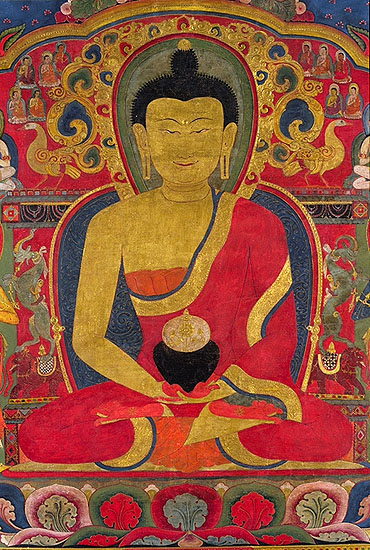
This painting of Shakyamuni Buddha, which is a fragment of a larger composition, is unique as it represents a period of transition in Tibetan thangka painting.
It displays many characteristics of the early, so-called "Kadampa" school that dominated central Tibetan Painting until the end of the 13th century, notably the slim, elegant figures of the standing bodhisattvas on either side, the poised posture of the kneeling larger figures to either side in the aureole and to the upper right, and the rows of miniature petals or beads below the lotus and on the horizontal elements of the throne. The sardulas or griffins standing on elephants on either side of the central figure and the double hamsa, geese flanking the aureole are also early elements, in part borrowed from early Indian Buddhist painting.
At the same time the painting departs from the "Kadampa" style and exhibits characteristics such as the raised gold work in the aureole and Chinese style of dress which are typical of the Eastern Tibetan style of painting that was beginning to emerge in the fourteenth century, particularly in the Dayab area of Eastern Tibet. Especially striking is the generous use of gold paint that makes up the body and face of the central Buddha, Shakyamuni, who holds a begging bowl surmounted by a floral design. Although the Buddha is shown in the Dhyanamudra considered typical of the Tathagata Amitabha, it is likely that Shakyamuni is portrayed because of the gold color and the bowl. Flanking the principle figure are two standing boddhisattvas in blue (right) and yellow (left), respectively holding a vajra (Tib. Dorje) and bell, the main ritual implements of Vajrayana Buddhism; these may represent Vajrapani (right) and Ratnapani (left). Above the Buddha are show an assembly of monks, while in the upper right are depicted attendant Boddhisattva figures. The painting is exceptional not only for its fine details and its dramatic use of gold but also by a sense of indomitable contentment radiated by face of the Buddha himself.
This painting is fragmentary, and was the central portion of a larger painting. From the composition we may suppose that the central figure entirely dominated the overall composition which was quite probably not that much larger than what we see here. Originally the painting was frayed and damaged around the perimeter, but it was brought to the present rectangular shape by the great French restorer Jean-Michel Terrier of Paris.
Detail: Detail of Buddha face
Detail: Entire painting
|


